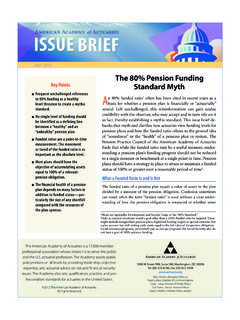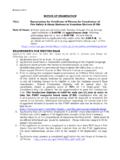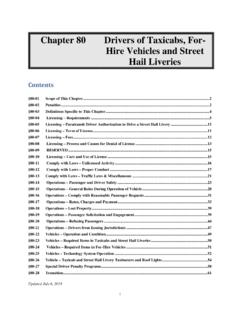Transcription of The 80/20 Rule: How Insurers Spend Your Health …
1 1 The 80/20 Rule: How Insurers Spend your Health insurance Premiums SUMMARY The Affordable Care Act holds Health Insurers accountable to consumers and ensures that American families receive value for their Health insurance premium dollars. One such mechanism is the 80/20 rule, or Medical Loss Ratio (MLR) rule. The 80/20 rule brings consumers value, increases transparency and accountability, and promotes better business practices and competition among insurance companies. The 80/20 rule requires insurance companies to reveal how much of premium dollars they actually Spend on Health care and how much on profits and administrative costs such as salaries and marketing. Now, with the implementation of the 80/20 rule, c onsumers can see how insurance companies Spend their premium dollars and make more informed decisions when purchasing Health insurance .
2 The 80/20 rule will become even more important beginning in 2014, when consumers and small employers will have access to state-based competitive Health insurance Marketplaces (also known as Exchanges) where individuals and small businesses can use the 80/20 information to compare the value of Health insurance plans. The 80/20 rule requires insurance companies to rebate any excess premium charged if they Spend less than 80% of premiums on medical care and efforts to improve the quality of care ( or at least 85% in the large group market). Under the 80/20 rule, insurance companies cannot keep more than 20% of premiums (or more than 15% in the large group market) for overhead and profits. Companies that Spend 80% (85% in the large group market) or more on medical claims and improving Health care quality already provide consumers with the required value for their premium dollars.
3 In anticipation of the effective date of the 80/20 rule, some Insurers have already modified their business practices and pricing to improve value to consumers for premium dollars. The deadline for insurance companies to submit their 2011 MLR reports to the Department of Health and Human Services (HHS) was June 1, HHS has analyzed these reports, and some of the key findings are: million Americans are getting the required value for their Health care premiums because most companies are spending at least 80% or 85% on medical claims and improving quality of care; million Americans are getting rebates; of Health insurance companies did not meet the required MLR standard in at least one market; 1 The data in this report are based on Insurers MLR reports submitted to HHS as of November 25, 2012.
4 A few companies submitted corrected reports after determining that some of the data initially submitted was inaccurate or submitted reports after the June 1 deadline. The data in this report excludes the top and bottom 5% to eliminate outliers where appropriate. 2 Rebates total approximately $ billion, an average of $137 per family; Annual enrollee Health insurance premiums in 2011 generally averaged between $1,700 and $4,700 in the individual market and between $2,400 and $ 5,400 for group Health plans; Profits for companies owing rebates averaged after payment of expenses, taxes, and rebates; Holding groups owing the most rebates include (in alphabetical order) Aetna, Cigna, Healthcare Service Corporation (HCSC), Humana, UnitedHealth, and WellPoint.
5 The 2011 80/20 rule results show important savings for consumers. These savings will continue in 2012 and beyond. Each time an issuer fails to meet the standard, rebates will be sent to enrollees. More importantly, the 80/20 rule sets a standard of transparency around plan performance, adding information about a plan s value to help inform consumers and employers plan choices. KEY RESULTS FOR 2011 80/20 Rule Rebates Explained 80 million Americans are covered by Health insurance plans subject to the 80/20 An insurer s MLR is calculated on a statewide basis, separately for the individual market, small group market, and large group market. It is not calculated for each individual or each employer group or for each plan or type of product (HMO, PPO, etc.).
6 For example, if an insurer has Health insurance business in a particular state in the individual market, small group market, and large group market, the insurer will have three separate MLRs in that state. If an insurance company does not meet the applicable MLR standard in a particular state market, it must give rebates to all consumers within that state market in proportion to the amount of premium those consumers paid. Rebates are calculated as follows: Rebate = (MLR standard insurer s MLR) x (premium taxes and fees). The following chart (Figure 1) shows the total number of enrollees in each market, as well as the number of enrollees who will benefit from a 2 Some Health coverage is not subject to the 80/20 rule, including employer based coverage that is self-funded, and Medicare Part C and Part D plans (Medicare plans will be subject to a separate 80/20 rule beginning 2014).
7 3 The number of enrollees is estimated using life-years. Life-years are the combined number of months that have been insured during the year, divided by 12. For example, if one enrollee was only insured for the first six months of the year, and another enrollee was only insured for the last six months of the year, together this would count as one life-year. 3 0102030405060708090 IndividualSmall GroupLarge GroupTotalNumber of Enrollees (in Millions) Market Figure 1 - Enrollees Benefitting from Rebates (in Millions) Total Enrollees by MarketEnrollees Benefitting from RebatesRebates total approximately $ billion, with about $ 399 million in the individual market, $290 million in the small group market and $403 million in the large group market (Figure 2).
8 While fewer companies in the large group market owe rebates (compared with the individual or small group market), the total rebate dollar amount is higher than in the individual market or the small group market. This is because companies in the large group market cover more consumers and collect more in total premiums than do the individual or small group markets. Individual, $399 Small Group, $290 Large Group, $403 Figure 2 - Rebates by Market (in Millions) IndividualSmall GroupLarge GroupTotal = $ Billion 4 Consumers in the individual market receive their rebate directly from the insurer , either as a cash payment or as a reduction in future premiums. For those enrolled in group Health plans, where the employer is generally the policyholder, Insurers do not know how much the employer and the employees each contributed to the premium.
9 Therefore, Insurers provide rebates for group Health plans to employers. Private employers are generally governed by the Employee Retirement Income Security Act (ERISA) and their handling of the rebates is regulated by the Department of Labor (DOL). DOL has issued guidance which indicates that the portion of the rebates attributable to employees contributions to premium generally must be used for the benefit of the employees covered by the Self-funded plans are not subject to the MLR requirements. Non-federal governmental employers handling of rebates is regulated by HHS. These plans must distribute the portion of the rebate attributable to employees contributions to premium either as a cash refund or by reducing employees contributions to premium for the upcoming year.
10 Because the MLR provisions require that Insurers submit reports and provide rebates, and HHS does not have authority to regulate most employers, the MLR reports filed by Insurers do not contain information regarding how employers are distributing the rebates. Average Premiums Insurers in the individual market collected more than $30 billion in total premiums in 2011, or 10% of the total reported Health insurance premiums nationwide. Small group Insurers received $80 billion in premiums, or 25% of the total. Large group Insurers collected $209 billion in premiums, or 66% of the total premiums. The following chart (Figure 3) shows the distribution of average annual premium per enrollee for each market. Most individual market enrollees paid annual premiums of $1,700 to $4,700 while most group market employees and their employers paid annual premiums of $2,400 to $5,400.



















